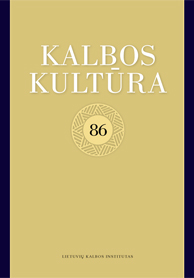Priešmokyklinio amžiaus vaikų rišliojo pasakojimo ypatybės
The Main Characteristics of Narrative in Preschoolers
Author(s): Ingrida Balčiūnienė, Agnė KalninytėSubject(s): Psycholinguistics, Baltic Languages, Preschool education
Published by: Lietuvių Kalbos Institutas
Keywords: developmental psycholinguistics; narrative; preschool age;
Summary/Abstract: The article presents the study of monologue (coherent) language of preschool-age children establishing the main micro- and macro-structural indications of Lithuanian preschool age children’s narratives. The study was based on the method of story generation according to a picture sequence: the children participating in the study were asked to tell a story according to a sequence of six related pictures. 24 children of 5-6 years old attending preschool education groups participated in the study; the sample was balanced in respect of social properties; all children were monolingual; they were not diagnosed with any speech-related or other developmental disorders. Every child was individually tested twice; hence, 48 narratives in total were collected. The narratives were recorded by a voice recorder, transcribed and morphologically annotated for an automatic analysis of narrative language and structure using CHILDES software. The analysis of the data collected identified the following individual and general properties: general productivity (including MLU and TTR), lexical diversity (namely, NP references), syntactic complexity (namely, CU structure), narrative structure, quantity of information and cohesion (namely, referential and linkage development) of the narrative. The results obtained enable us to compare individual results, to make general conclusions and to identify the general tendencies of narrative development.
Journal: Bendrinė kalba (iki 2014 metų – Kalbos kultūra)
- Issue Year: 2013
- Issue No: 86
- Page Range: 212-236
- Page Count: 25
- Language: Lithuanian

